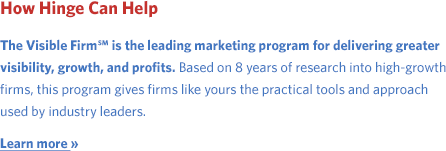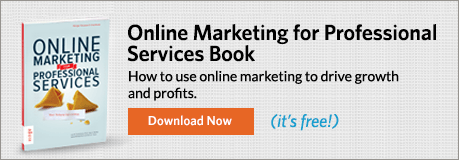Lead generation means different things to different firms. For some, it might simply mean getting referrals from clients who are pleased with their work. For others, it might mean attending networking events.
While seeking client referrals and networking are both legitimate approaches to lead generation, they are no longer the whole story. Not even close.
Let’s look at what lead generation has evolved into, starting with the basics.
Lead Generation Defined
For our purposes, lead generation is simply the front-end of the process of identifying potential new clients. It might include referral generation and professional networking, but your lead generation techniques should go further to encompass a full range of targeted online and offline measures. Think of it as a system that generates, qualifies, and nurtures leads until they become new business opportunities.
Why Lead Generation Matters
An effective lead generation strategy and system is essential to the health of your firm. The fact is, the market is changing. All firms must adapt to shifts in demand, delivery strategies, market dynamics, and more.
Some firms are winning, while others are falling behind. The firms with the strongest lead generation strategies are best prepared to be the ones that develop new business and thrive.
What You Need to Know Now
So how can you make sure your firm is among the winners? Here are seven things every managing partner needs to know about lead generation to succeed in today’s marketplace.
1. Leads can come from many sources, so you need a balanced strategy.

The most successful firms generate leads offline and online. The reason shouldn’t be surprising – it takes a diverse set of tactics to capture the many different types of leads that stand to be generated.
Roughly half of firms’ leads come from online sources like search, social media, email marketing, online advertising, and others. The other half come from face-to-face sources such as in-person networking, speaking engagements, and trade shows.
Our research shows that when these approaches are balanced, that’s when firms generate the most leads and are most profitable. The fastest-growing and most profitable firms balance a diverse set of lead generation techniques to leverage all available opportunities. Just take a look at this graph.
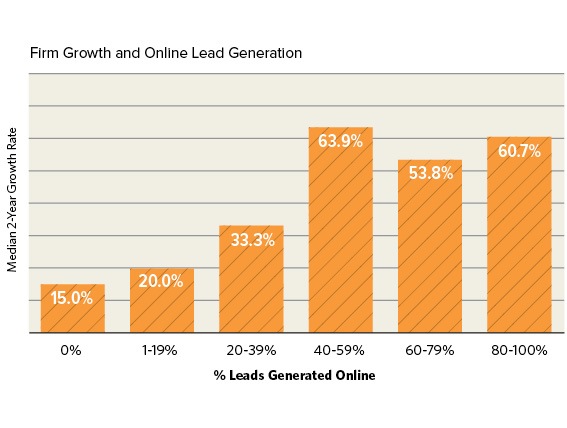
Firms that generate leads online are more successful, on average, than firms that don’t. But strikingly, the most successful firms are those that generate somewhere around 50% of their leads online. This balanced approach leads to the greatest success.
2. All leads are not equal – but that doesn’t mean they’re not all valuable.
We all know that some leads are worth more than others. The leads that are most valuable today are those that stand a reasonable chance of becoming good clients in the short term.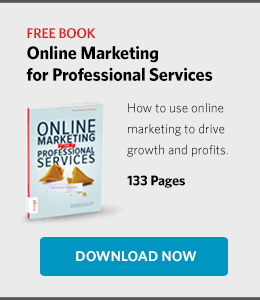
But because they are not ready to buy today doesn’t mean that they are not valuable in your overall strategy. In many firms, there is a tendency for those in business development roles to devalue and reject leads that are not ready to buy today.
This is a mistake for several reasons. First, some potential clients are not ready now, but will be in the future. Will they seek you out then?
Second, some leads may not be a good fit with your firm, but may refer others who are a good fit to you. Are you treating them as a valuable referral source?
Third, some firms may not realize they have an emerging need that you can help them with. Will you be able to help them identify and understand that need?
We’ll talk more below about how a system of qualifying and nurturing leads can extract more value from the leads you do generate.
3. There are multiple kinds of referrals.
Remember when we talked about referrals above? For many firms, referrals are the favored technique for lead generation. And it’s true – referrals are important. But referrals are also more complicated than most firms realize.
Traditionally, many firms have thought of referrals as coming from clients or colleagues from other professions. These are major sources of referrals, but they’re not the only ones. In fact, our research shows that 81.5% of buyers have received a referral from someone they have never worked with.
Who are these other referrers? Members of the informed marketplace. Many industry audiences may know you by reputation or through familiarity with your educational content. And these folks are valuable referral sources who you must leverage to remain competitive. Consider the sources of reputation-based referrals.
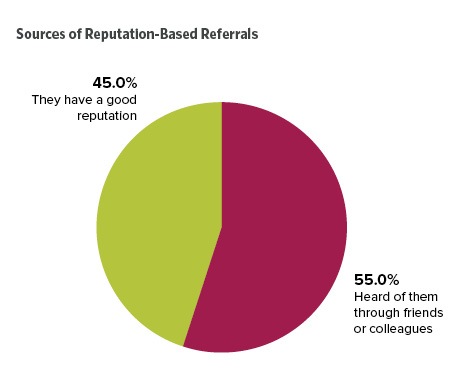
About 45% of reputation-based referrers make their referrals based on a perception of firms’ good reputation. The other 55% are happy to make a referral given that they have heard of a provider through trusted friends or colleagues. In both cases, a positive reputation is a tremendous asset.
Today, the most effective firms take a multi-channel approach, generating referrals both from clients and from their wider industry audiences. By becoming Visible Experts, your firm can utilize your knowledge and reputation in the field to generate more referrals and more leads. Importantly, high visibility expertise also makes it easier to close deals.
SEE ALSO: A 7-Step Program to Becoming a Visible Expert℠
4. You can easily lose a good lead.
Closing a deal is the whole point, right? Unfortunately, it’s all too easy to lose a good lead. In fact, over 50% of professional services buyers have ruled out firms they were referred to before they even talked with them. Yikes!
You can take a look at the top reasons buyers rule out referrals to get a feel for all the ways leads lose interest.
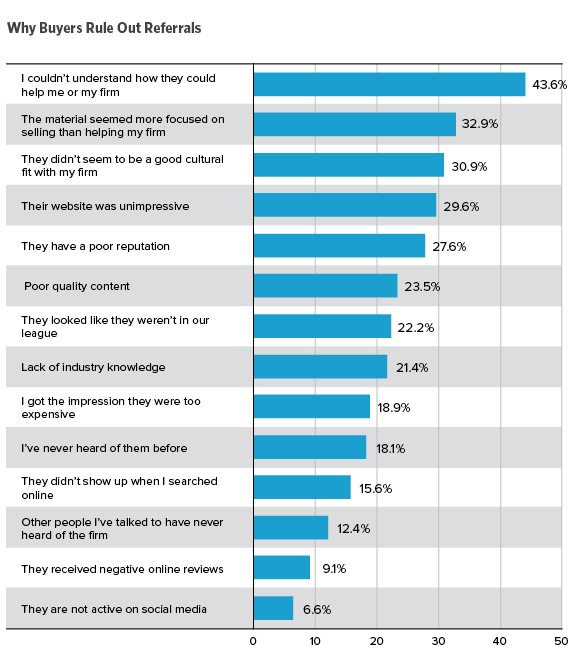
In order to grow more qualified and comfortable with you, leads need to understand how you can help in the first place. Your website, your content, and your style of engagement should all be designed to give leads all the information they need on your expertise and services.
As you share this information, though, remember that education has to be your watchword. If you’re too sales-oriented – if you’re all about you – buyers will be turned off. You have to focus, therefore, on your audience’s challenges and how best to solve them.
To take just one example, your blog posts shouldn’t be about your services, at least not explicitly. They should focus on common challenges among your target audience and how to tackle those issues.
5. Qualifying leads is critical.
We talked a bit about qualifying leads in Item 2 above. Not every lead is a potential client. Some may be too small or too large. They may be in the wrong industry or they may not have a current recognized need. But that doesn’t mean they are of no value.
One way of understanding lead qualification is to start with the buying process. Of course, not every lead is at the same stage of the buying process.
Sure, some leads are ready to engage right now. These are great opportunities. But there are many, many more who might make fantastic clients – someday. They’re in your target audience, but they’re not quite ready to buy yet. Instead of simply ignoring or waiting passively for these buyers to come around, it’s important to qualify them in an active way.
Through content, you can help them understand their challenges more deeply or in a new way. You can demonstrate the different types of solutions available, and how you approach their problem. Through closer and closer engagements, these clients will become qualified.
Finally, some audiences simply aren’t a good fit and probably won’t ever be. But they may make a strong referral source. Ignore these readers at your peril. Continue to nurture them as referral sources. Use low cost online techniques to make the cost benefit work.
6. You must nurture and educate most leads before they can become an opportunity – and then a client.
The lead nurturing and education process we’ve discussed isn’t just a good idea – it’s basically a necessity. Most buyers just aren’t ready to buy at first contact. Rather than wish it were otherwise, you need to have a strong business development process in place to engage with leads and draw them through the buying process.
As we’ve discussed, a key first step is to provide content marketing to establish your expertise. Another important benefit of content is that it grows your visibility, cementing your credibility and generally making closing easier. Influencers and referral sources will need love too. So don’t make the common mistake of focusing on direct prospects to the exclusion of everyone else.
That may sound like a lot to juggle. Some folks will say, “I’m too busy.” But that’s just not a great excuse. If you’re too busy to grow and succeed, you may want to change your line of work – before the industry leaves you behind.
7. You must have a structured lead generation process.
You can’t fly by the seat of your pants when it comes to lead generation. This is a key reservoir of future business. You need to treat it that way, building out a detailed lead generation strategy and system (or processes) to fully implement that strategy.
And as you implement your strategy, it’s critical to track your results and adjust your approach accordingly. Consider every step of the sales funnel, and identify where you may face challenges or opportunities.
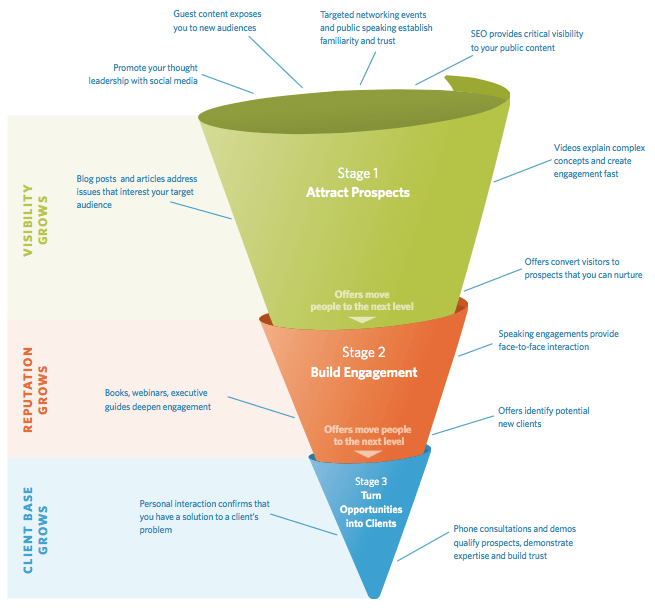
Lead generation has been the topic of all too many misconceptions – and entrenched bad habits. Thankfully, it’s changing.
In this new and more competitive professional services world, firms need a new scientific approach, as well as a long-term systems-oriented view. If they’re able to achieve this perspective and carry through for the long haul, they’ll be positioned to succeed.
Additional Resources
- Hinge’s Online Marketing for Professional Services book contains everything you need to know about creating a marketing strategy that accelerates firm growth.
- Our Lead Nurturing Guide for Professional Services explains how you can craft a powerful lead nurturing strategy for your firm, so you can turn leads into clients.
- Join us on LinkedIn for more insights and resources on lead generation.
